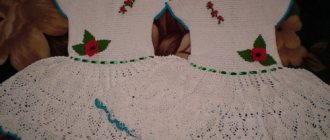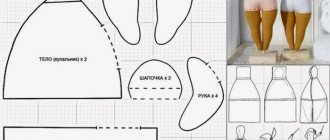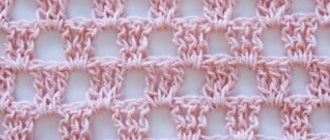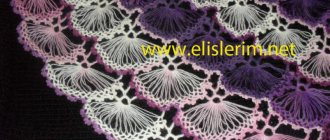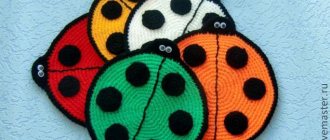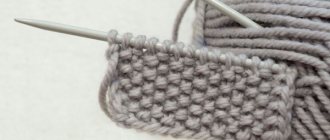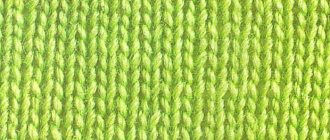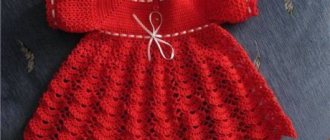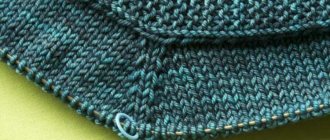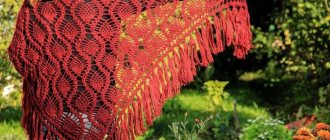Yarn and tools
To work in the fillet technique, yarn with a cotton composition is used: thread “Snezhinka” from the Kirov Spinning Mill, “Poppy”, “Rose”, “Iris” from the Gamma factory.
The size of the hook is selected depending on the thickness of the thread. For the most part, hooks of sizes 0.2, 0.5, 0.8, 1 are used.
Basics of fillet knitting technique
This type of weaving is based on a specially woven mesh. By alternating various techniques, a pattern is formed on it. Craftswomen have learned to harmoniously weave three-dimensional elements into a pattern:
- lumps;
- arches, lace;
- brushes;
- fringe and others.
Sections of fabric made using the fillet technique are often included in the main product, combined with other types of sewing and knitting. The result is an original piece of clothing or decor.
Thanks to the abundance of sites on the Internet dedicated to handicrafts, you can be inspired by published photos of things and bring your idea to life, creating a real masterpiece. In addition, this type of creativity is considered budget-friendly; cotton yarn costs no more than 200 rubles per skein, the length of the thread reaches 400 meters.
The main elements necessary for “fillet”:
- air loop;
- double crochet (dc).
Fillet knitting pattern for curtains
The size of the proposed curtain is 66x39 cm
Fillet crochet curtains. Diagram and description
To decorate the interior and clothing, many combine fabric with sirloin motifs.
The patterns proposed in this article with a description of fillet crochet will always remain relevant for any needlewoman who loves and appreciates beauty.
Author: Irina Nikolaeva
Article design: Vladimir the Great
Sirloin mesh. Option 1
This type of mesh is considered the basis of the “fillet”. Any classic product begins with it, be it a napkin, tablecloth, summer T-shirt or socks with an openwork texture.
Master Class:
- Cast on the estimated number of loops in the chain.
- To lift, do 3 ch.
- Knit in the opposite direction to the next loop from the rise, then 1 dc, 1 ch and so on until the end of the row.
- In the next row, make three lifting loops; above each element of the bottom row, knit the same. Repeat the CCH over the CCH, and repeat the same number of VPs over the VP.
What is fillet mesh and why doesn’t everyone succeed?
If you look at a selection of photos of fillet mesh, its widespread use becomes obvious. This is a completely independent openwork for summer handicrafts and an excellent basis for other types of needlework.
The pattern itself is very simple - alternate 1 double crochet stitch and 2 chain stitches, then again a double crochet stitch and 2 chain stitches, and so on until the end of the row. Then we turn and knit in exactly the same way, only be sure to knit the base from the top of the lower columns, and not from the chain loops.
You should get square windows. This is the answer to those who have trouble crocheting fillet mesh patterns.
Probably, beginners make typical mistakes in their work:
- knit one air loop between the columns, then when filling the narrow cells the pattern merges;
- too long stitches with 1 or 2 crochets distort the proportions of the squares;
- the hook is inserted into the free gap, covering the air loops, then an openwork resembling a honeycomb is obtained, it is beautiful, but not a loin mesh at all.
So, it is already clear that a typical French mesh or “loin” (as needlewomen call it) is knitted in squares. The basis, which came to us from the Middle Ages and became widespread, has many modern variations.
Note! Crocheting napkins for beginners - patterns of simple and beautiful knitted napkins with a step-by-step description of the knitting processSirloin mesh. Option 2
This type of mesh is also considered traditional; it differs from the first type in the sparser arrangement of partitions made of SSN. This allows you to make a product with a spacious openwork texture. Suitable for knitting summer tops, elegant dresses, festive tablecloths.
Scheme:
- Knit a chain of the required number of VPs.
- Work three stitches for the rise and two stitches for the arch in the next row.
- Alternate 1СН, 2 VP to the end.
- In the next row, perform the same one over each chain, over the dc – 1 dc.
The canvas looks like numerous cells located one above the other.
Filling the grid with a pattern
To make a pattern on a grid, you can use a pattern designed for embroidery on canvas. Canvas is similar to fillet, but its cells are smaller and denser. Schemes have been published in large quantities on the Internet, on sites with handicraft themes.
You can develop simple schemes yourself. To do this, you need to take a notebook in a box and, coloring in the squares, draw a shape (circle, heart, oval, asterisk). Active users of office programs can create a diagram of any complexity on a computer, coloring the future drawing in specified colors.
Empty cells are filled using double crochets. They are knitted for each loop at the base of the cage. This means that the hook should not be inserted into the buttonhole itself, but should be caught in the lower sequence of air loops. In this version, the canvas looks more neat and smooth.
Curly mesh
The loin mesh looks much more interesting, in which the cage is represented not by straight sides, but by inclined arches. The execution technique is more complicated than in the traditional version, but it looks interesting on the product.
Master Class:
- Dial a chain from VP.
- Make 3 ch for lifting, 3 ch, dc, repeat the sequence until the row is completed.
- In the next row, perform 3 VP lifting, 5 VP between the DC in the previous line.
It is important to remember that the number of loops in the initial chain for a particular product may differ from the diagram. In this case, you need to knit a sample from the selected yarn and calculate the loops. The number of chain stitches in the chain should be divided by three plus one initial loop for the first dc.
Filet Crochet for Beginners: Mesh
Before you start knitting , prepare all the tools necessary for this. You will need:
- yarn (most often “Iris” threads are used for fillet knitting);
- hook (No. 1 or 1.5);
- scissors.
Below we will use the following notation:
- V. n. - air loop;
- p.p. - lifting loop;
- sc - single crochet;
- Art. with nak. - double crochet.
As mentioned above, first you need to learn how to knit a square mesh. It consists of empty and filled squares of the same size. The process of its creation can be divided into the following stages:
- Dial a chain of 15 v. P.
- Knit 3 sts.
- Knit another 2 sts. P.
- Knit st. with nak. in the eighth loop from the hook.
- Dial 2 more v. P.
- From the base of the previous double crochet, count 2 ins. p., and in the third knit another st. with nak.
Continue knitting the mesh until the end of the current row.
As soon as the first row is completely knitted, you need to start a new one. To do this, turn the product over, dial a chain of 5 v. p. (3 p. p. + 2 v. p. forming a square) and knit st. with nak. To knit a filled square , you need instead of 2 v. p. knit 2 tbsp. with nak. In this case, the hook can be inserted both into the loops of the previous row and under the chain. Complete the square st. with nak. As a result, you will get a square consisting of four such columns.
The number of air loops that need to be cast on before starting knitting depends directly on the size of the product. To understand how many loops you need to cast on, calculate the number of squares in your product. Let's say that our future product consists of 20 cells. The size of one cell is 3 cm. p. Thus, we must cast on a chain of 60 air loops.
Advice for beginning needlewomen: when creating a mesh, strictly observe the number of loops. Make sure that their number does not increase or decrease. A standard check in loin knitting consists of a double crochet, two chain stitches and another double crochet.
How to add and subtract a cell?
The simplest products created using the fillet knitting technique have the shape of a square or rectangle. However, on the Internet you will find products in the form of an oval, circle, polygon and even a flower. To learn how to create such napkins, you need to be able to increase and decrease the number of squares in a row.
The diagram on the left shows how to add cells to the right and left. The technique of adding filled cells is demonstrated separately. Let us describe this scheme in more detail .
- To add loops on the right, you need to cast on a chain of 7 sts. p. and then knit st. with nak.
- To add a square to the left, you need to dial a chain of 3 v. p., and in the lower left corner of the previous square, knit a stitch with four crochets.
- To add a filled cell to the right, you need to dial a chain of 5 v. p., and in the fourth and fifth loops from the hook, knit a st. with nak.
- To add a filled cell to the left, you need to throw the thread over the hook, insert the hook into the base loop of the previous stitch and knit a st. with nak. This procedure must be repeated 2 more times.
Reducing cells is easier than adding . In order to reduce the number of cells in a row, you need to knit 4 half double crochets. Make 1 lifting loop, then insert your hook into the adjacent loop and pull the yarn straight through the existing loop on the hook. You will learn more about how to knit half double crochets in this video.
How to knit curly checks?
In some patterns for fillet knitting, another decorative element is found - a figured check.
A diagram of such a cell is shown on the right. The figured cell consists of two rows. Knit the first row according to the pattern: st. with nak., two in. p., sc (in place of the double crochet), two in. p., art. with nak.
The second row of the figured square is knitted according to the pattern: st. with nac., 5 c. p., art. with nak. (knitted above the double crochet of the previous row).
Useful tips
No one is immune from mistakes. Even experienced knitters sometimes have to unravel a product in order to correct shortcomings in their work. What can we say about novice craftswomen? Below we will provide some useful tips to help you avoid common mistakes made by knitters.
- Try not to use a hook that is too thick. Otherwise, your product will have many holes, which will only ruin its appearance. Ideally, the hook should be slightly thinner than recommended by the manufacturer.
- If you are going to knit a large fabric, then purchase the necessary yarn in advance. Otherwise, the store may not have the desired shade.
- Try not to knit too loosely. At the same time, there is no need to knit too tightly.
- First, learn how to knit simple patterns.
- The thickness of the threads determines the size of the product, so before you start working, try knitting a small fragment of your chosen pattern.
We have given some useful tips for beginning knitters and listed the main elements found in loin knitting. Having mastered them, you can safely start creating your first products.
Sirloin rules
Despite the apparent simplicity of fillet knitting, it has certain rules that allow you to imitate lace fabric. They look like this:
- If the process begins with an empty cell, then a pair of VPs must be knitted additionally and the hook must be inserted into the third VP.
- If there is a filled cell at the beginning of the row, then make the DC in the fifth element.
To make it easier to master these rules, you need to focus on the previous row - if at the bottom of the arch, then there will be a filled cell on top and vice versa.
Fillet knitting pattern for napkins
Fillet crochet (patterns and product descriptions are presented below) is used to create napkins.
In order not to make a mistake in the calculation, you need to make markings on the diagram, bypassing 10 cells.
The edges of the product can be decorated with binding; a diagram for it can be given, either separately or together with the main diagram.
Napkin “Rose”
To make this napkin you need 46ch, there are 39 rows in this product. You need to knit from the bottom up.
Here you need to add and subtract cells.
Decrease rules
Clothes are often knitted using fillet. The details of, for example, a summer T-shirt do not look like a rectangular fabric. It is necessary to make decreases in the armholes so that the model sits well on the body. Reduction is carried out by canceling the entire cell.
Deductions are made as follows:
- If there are three VPs at the base of the cell, then at the beginning of the line, instead of them, three connecting posts are knitted along the chain to the next cell.
- At the end of the row, they simply do not knit one square, starting the next row from the penultimate element.
Addition rules
To increase the size of the canvas, additions are made along its edges. Increases can be made in the form of one, two or more cells, depending on the requirements for the shape of the product.
Increase procedure:
- At the beginning of the row, perform a chain in which the number of chain stitches is enough to complete the wall and roof of the cage.
- Using the dc, close the element into the loop of the previous row in which the dc is located.
If you need to lengthen the fabric using a filled cell, then you need to knit a DC into each of its component loops.
Crochet a dress using the fillet technique
Fillet lace dress, author Lyudmila Ustyuzhanina
Yarn ANNA TWIST, hook 1, 5.
Dress White Lotus, fillet knitting
Work by Margarita Kosheleva.
Sundress from Red Valentino
Knitted from Semenovskaya yarn “Tenderness” 50% cotton, 50% viscose, 400m/100g, hook 1.5 Ciover. The sundress weighs 400g, size 40-42 (knitted with a simple fillet mesh). The trim is knitted separately and sewn on top like an applique. Colors: blue, light blue, turquoise, white, red and very little yellow and black for finishing. I bought all the colors for 200 grams, the remainder would be enough for a top.
Thai crochet dress
There is no explanation for the dress, but there are large and good diagrams.
Safari dress, fillet knitting
Size: 38. You will need: Novita Bambu yarn (50% viscose bamboo, 50% cotton, 113 m/50 g) -200 g. light brown, 100 g gray, 100 g. white and 50 g pink, hook No. 2. The front of the dress is knitted from the center.
Dress in ethnic style, fillet knitting
- Work by Irina Horn.
- A-line dress. This pearl gray dress is suitable for the beach and summer vacation. Threads are 100% cotton, 100 g 530 m, long sleeves protect from sun rays, and due to the pattern they are quite comfortable even in the heat.
- Size 44-46.
- You will need: 500 g of yarn (100% cotton; 100 g/530 m;); hook No. 1.1.
Black dress, loin knitting
Loin knitting, dress with multi-colored embroidery
- Size: 38-40.
- You will need: Iris yarn (100% cotton) - 500 g of turquoise or yellow colors, 25 g each of red, white, purple, lilac and green colors, hook No. 0.85.
- Attention! Before starting work, make a full-size pattern.
Dress from a Japanese magazine, fillet knitting
Volumetric knitting on fillet mesh
“Fillet” differs from other knitting techniques in that it allows you to give the product a 3D effect. This is possible by knitting four DCs under each side of the mesh. The result is waves that frame the mesh in different directions, forming an original three-dimensional pattern or simply filling the canvas.
Fantasy ornaments made with yarn of different colors look especially interesting. To realize creative ideas, needlewomen use floral motifs, Greek-style zigzags, and geometric shapes. To weave a mesh base, they do not use thin cotton thread, but thick, strong yarn. After all, she will hold a lot of knitted ruffles, which together give a weighty volume.
Knitting using the loin technique is considered easy, but requires certain skills in carefully executing the elements. The result is amazing products that imitate lace. Details made with fillet decorate tablecloths, collars and sleeves of blouses, and can be found in children's blankets and decorative items.
